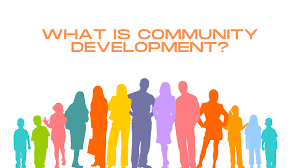Community development is a comprehensive approach to enhancing the well-being of individuals and communities through collaboration, empowerment, and sustainable practices. As societies face complex challenges such as economic disparities, environmental crises, and social inequalities, community has emerged as a crucial mechanism for fostering resilience and progress. This article delves into the essence of community development, its key principles, methods, and the impacts it brings to individuals and the broader society.
Understanding Community Development

Community development is a process where individuals and groups in a community come together to address issues affecting their lives. The goal is to empower people to take collective action, thereby improving the community’s quality of life. It emphasizes participation, equity, and sustainability, enabling communities to develop long-term solutions to their challenges.
This process is not limited to specific regions or demographics; it is applicable in rural and urban settings, marginalized populations, and affluent neighborhoods. The focus is always on creating an environment where individuals can realize their potential and contribute to the community’s overall growth.
Key Principles of Community Development
Several principles underpin community development, ensuring its effectiveness and sustainability:
- Empowerment
Empowerment involves providing individuals with the tools, skills, and confidence to take control of their circumstances. This principle ensures that community members are active participants in decision-making processes, fostering a sense of ownership and responsibility. - Participation
Active participation is the cornerstone of community development. By involving community members in planning and implementing initiatives, projects are more likely to succeed and meet the actual needs of the people. - Equity and Inclusion
Addressing disparities and promoting equality are vital in community. Efforts must focus on including marginalized groups and ensuring that resources and opportunities are accessible to everyone. - Sustainability
Sustainable development emphasizes long-term solutions rather than temporary fixes. It considers economic, environmental, and social factors, ensuring that progress benefits future generations. - Capacity Building
Building the capacity of individuals and institutions is a critical aspect of community development. It involves equipping people with the skills and knowledge needed to address challenges effectively and independently.
Approaches to Community Development
Various approaches can be employed in community , depending on the specific needs and goals of the community:
- Asset-Based Community Development (ABCD)
This approach focuses on identifying and leveraging the existing assets within a community, such as skills, resources, and institutions. Rather than dwelling on problems, ABCD emphasizes strengths and opportunities for growth. - Needs-Based Approach
The needs-based approach identifies the gaps and challenges within a community, then develops strategies to address these issues. While effective, it is often combined with other methods to ensure a balanced perspective. - Participatory Development
Participatory development prioritizes involving community members at every stage of the project. By doing so, it ensures that initiatives are relevant and have the support of the people they aim to serve. - Rights-Based Approach
This method integrates human rights into community development, advocating for policies and actions that uphold dignity, freedom, and equality. - Sustainable Livelihoods Approach
Focusing on economic resilience, this approach seeks to enhance the capacity of individuals and families to secure sustainable means of livelihood while preserving natural resources.
The Role of Community Development in Addressing Social Issues

Community development plays a pivotal role in tackling various social, economic, and environmental challenges. By empowering individuals and fostering collective action, it helps address issues such as:
- Poverty Alleviation
Through skill-building programs, microfinance initiatives, and job creation, community development helps reduce poverty and enhance economic stability. - Improving Health and Well-Being
Health-related community development projects aim to improve access to healthcare, promote healthy lifestyles, and address public health issues like sanitation and nutrition. - Promoting Education
Community-based education initiatives increase access to quality education, improve literacy rates, and provide opportunities for lifelong learning. - Environmental Conservation
By involving communities in environmental projects such as reforestation, waste management, and renewable energy adoption, community development contributes to sustainability and climate change mitigation. - Strengthening Social Cohesion
Bringing people together to work towards shared goals fosters a sense of belonging, mutual respect, and understanding. This strengthens social bonds and reduces conflicts.
Challenges in Community Development
Despite its potential, community development faces several challenges that must be addressed to achieve meaningful outcomes:
- Resource Constraints
Limited funding, human resources, and infrastructure can hinder the implementation of community development projects. - Resistance to Change
Community members may resist new initiatives due to fear of the unknown or attachment to traditional practices. - Power Dynamics
Unequal power relations within a community can lead to the exclusion of certain groups, undermining inclusivity and equity. - Lack of Collaboration
Silos among stakeholders, such as government agencies, non-profits, and community members, can reduce the effectiveness of development efforts. - Sustainability Issues
Ensuring that initiatives remain impactful over time requires careful planning and ongoing support.
Strategies for Successful Community Development

To overcome these challenges and ensure the success of community development initiatives, certain strategies are essential:
- Fostering Partnerships
Collaboration between governments, non-governmental organizations (NGOs), private sector entities, and local communities creates a synergy that enhances project outcomes. - Capacity Building and Training
Investing in the skills and knowledge of community members and leaders enables them to address challenges effectively. - Adaptive Planning
Flexibility in planning allows for adjustments based on changing circumstances and emerging needs. - Community-Led Monitoring and Evaluation
Involving community members in monitoring and evaluating projects ensures accountability and provides valuable feedback for improvement. - Leveraging Technology
Digital tools and platforms can enhance communication, data collection, and resource mobilization, increasing the efficiency of community development efforts.
Examples of Community Development in Action
Community development initiatives have brought about transformative depobos changes in various parts of the world. For instance:
- Agricultural Projects: Rural communities have benefited from initiatives that provide access to modern farming techniques, irrigation systems, and market linkages.
- Urban Renewal: Revitalization programs in urban neighborhoods have improved housing, created public spaces, and fostered economic opportunities.
- Education Programs: Grassroots education initiatives have empowered women and girls in marginalized communities, breaking cycles of poverty and illiteracy.
The Future of Community Development
As the world becomes increasingly interconnected, the importance of community development continues to grow. Emerging trends in the field include:
- Emphasis on Sustainability
Greater focus on integrating environmental sustainability into community projects is essential to address climate change and resource depletion. - Technology Integration
The use of digital tools for data collection, virtual collaboration, and resource sharing is becoming a cornerstone of modern community development. - Inclusive Development
Future efforts will likely prioritize inclusivity, ensuring that marginalized groups are actively involved and benefit equitably. - Global Collaboration
Cross-border partnerships and knowledge-sharing among communities worldwide are paving the way for innovative and impactful solutions.
Conclusion
Community development is more than a strategy—it is a commitment to building societies where everyone can thrive. By fostering empowerment, participation, and sustainability, it addresses the pressing challenges of our time while paving the way for a brighter future. As stakeholders work together, the potential for transformative change becomes limitless, ensuring that communities remain resilient, vibrant, and inclusive for generations to come.
